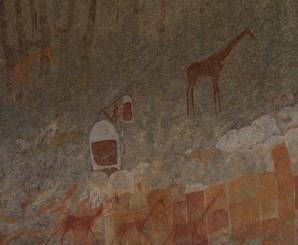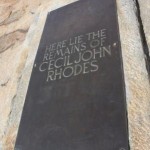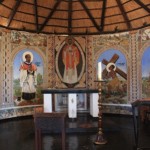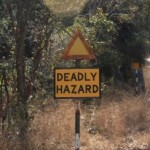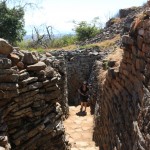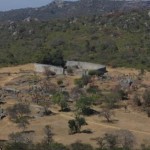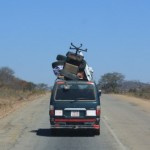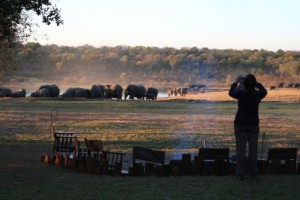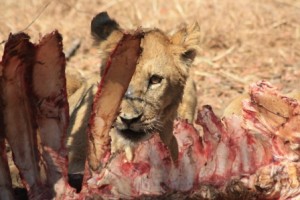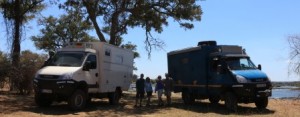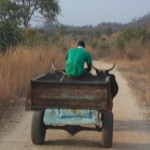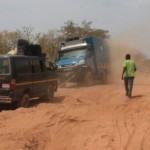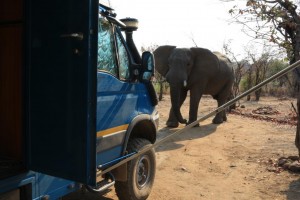August 2014
We approached the crossing into Zimbabwe with some trepidation for two reasons. First, on leaving Botswana we had to resolve a discrepancy with Cuthbert’s Carnet (a residual problem from the South African border over 2 months ago). If the Botswanan official was not prepared to deal with the matter, we could have to go back to South Africa to sort it out. Secondly, we had read many tales of the ‘fun and games’ formalities of entering Zimbabwe. What would ‘Uncle Bob’s’ border chaps make of Cuthbert and all his gear?
In the event, we had no snags with either of these. The Botswanan official had a few choice words regarding the previous mis-handling of the Carnet at the SA/Namibia border, but was very helpful in sorting it out. And the entry into Zimbabwe was, as they say, ‘a walk in the park’. All thoroughly nice chaps!
Now just a quick 100ish kms up the road to our first target destination: Matopos National Park. We found an isolated campsite just outside the park, which we had all to ourselves, and celebrated our first night in Zim with a nice glass of Shiraz, sat on the rocks watching the sunset over the Matopos Hills, with zebra and giraffe grazing near the waterhole in the valley below. This is what we came to Africa for 🙂
Matopos
Matopos is a beautiful park near Bulawayo, full of extraordinary rock formations and an extensive range of some of the most impressive pre-historic cave art in the world. However some of the best cave drawings are not easily accessible. We visited two sites, one of which required some bravery on Cuthbert’s part to get us up a deeply rutted, washed-away track, with several low tree branches to negotiate (thus adding to the increasingly ‘lived-in’ look that is accumulating on poor Cuthbert’s external appearance as we move across Africa).
The second of the two rock-art sites that we chose to visit, required a jungle-bashing four and a half hours round trek on foot, following a feint and randomly placed succession of arrows painted onto rocks, to guide us over three ridgelines to the site of the cave art. This is rather ‘Indiana Jones territory’ and not an easy-going walk in the park, but the scenery and the amazingly well preserved cave art (some of which is apparently up to 10,000 years old) more than made up for our aching legs the next day!
At another particularly scenic, but this time easily accessible, spot (modestly entitled ‘The World’s View’) the Matopos Park hosts the remains of the man who is credited with founding the nation of Zimbabwe (or rather its predecessor, Rhodesia): one British diamond entrepreneur – Cecil Rhodes. Rhodes, having made his fortune in diamond mining with De Beers in Kimberley, moved north and effectively formed his own personal nation by giving the Ndebele chaps a bit of a bashing and successfully duping their King Lolubela into signing over the rights to the land in 1888. Obviously a lot of water has passed under the bridge (so to speak) since then, but it’s an interesting story if you have time to Google it.
The Matopos Park infrastructure is clearly severely lacking in investment, with rough roads and very badly run-down facilities such as toilets and campsite ablutions (luckily with our ‘luxury Cuthbert’, we don’t need to take advantage of these). However one reflection that stayed with us, was how friendly, helpful and smartly dressed the staff were. They took great pride in their work and with their extremely limited resources, did a great job of keeping the park and the facilities clean and tidy, despite the dilapidated state of repair.
On the short route between Matopos and Bulawayo we did the obligatory tourist ‘box-ticking’ sights of Cyrene Mission and the Khami Ruins; a pleasant day’s sight-seeing, but nothing to blow your socks off. The town of Bulawayo was an interesting stop-over for a couple of days; not exactly a touristy destination in its own right, but by standards of African towns, it’s not a bad place. It is a good source of Econet Data-Sim cards and the essential wine/beer/food replenishments!
We learned that the wide open boulevard-style, tree-lined streets had originally been designed so as to allow a cart pulled by 12 oxen, to do a U-turn; so plenty of room for Cuthbert then!
Whilst we were there, Marcus received the ‘Ice Bucket Challenge’ from our friend Andy Roe, travelling in New Zealand. Our firewood store-chest made a good improvised ‘ice bucket’ for the cold water and Marcus met the challenge on a sunny afternoon in the central Bulawayo campsite (not sure what the campsite’s gardeners made of the scene 🙂 ).
So what do we make of Zimbabwe so far? The country is not without controversy on the international stage; but is it ‘travel friendly’ and is it right to come here?
We have been in the country almost a week now. We have seen their second most popular national park (after Victoria Falls), the second largest city (after the capital, Harare) and a good stretch of cross-country driving. So far, we can honestly say that it has been a great experience and we have loved it. The border entry was as easy as we have ever experienced anywhere in the world. The people are the most friendly, polite and helpful we have yet to come across in Africa. The main roads between the larger towns are mostly newly surfaced and, by African standards, a very easy drive. There are (very) frequent police road-blocks outside the towns, but as a foreign registered vehicle we are usually waved through without stopping. On the few occasions when we have been stopped, the officers have been friendly, polite, sociable and reasonable, carrying out ordinary, routine checks.
So far, so good….. 🙂
The currency situation in Zimbabwe is vaguely comical. The Zim dollar was abandoned in 2009 amid astronomical levels of inflation. We have heard amusing tales from ex-pats living here at that time; such as a dress in a boutique having a zero added to the price within the time it took to try it on and take it to the cashier to pay; and the supermarket cashiers weighing the bank notes from customers at the check-out, rather than attempt to count the huge wad of notes required for even a very basic shopping basket!
The Zim dollar was replaced mostly by the US$. This has made currency exchange easy for visitors and thwarted the profiteering of the currency exchange touts on the streets (although they have now changed their commercial activity to selling the old Zim currency two-billion dollar bank notes as tourist souvenirs!) However… it’s not quite as straightforward as simply taking your US ‘green backs’ to Zim and spending! One foreign currency is not enough for Zimbabwe! Only the paper notes (or ‘dollar bills’ as our American cousins would say) of the US currency are used. For denominations of less than one US dollar, the South African Rand is used. In theory, other currencies can be used a legal tender, but the prevailing exchange rate will not be favourable, so in practice other currencies aren’t much used. Confusing, huh?
This reliance on foreign currency means that the Zim authorities and the banks have no control over the currency issue. This leads to an erratic supply/circulation of currency, which in turn results in a shortage of particular denominations at certain times, particularly at the smaller end of the financial scale: i.e. the coins and US$1 notes.
We are currently finding plenty of US$5, US$10 and US$20 notes in circulation, but if a transaction totals say US$3, there will rarely be the US$2 change available. In Bulawayo, even the banks are reluctant to exchange higher value notes, preferring to hang on to whatever small stocks of precious US$1 bills they hold.
So you can imagine the trouble that we had on arrival in the country, with the US$100 notes handed out by the ATM! Initially, where we were unable to pay the correct price in US$, we paid the amount rounded-up to the next US$5 and were given a hand-scribbled ‘IOU Note’ for the balance. Hmmmm, this seemed ‘convenient’ for them! But full credit to the Zimbabwean people, they always procured the outstanding change for us and had it ready, with an apology and a smile, when we returned!
Finally, after 2 days of searching in Bulawayo, visiting every bank we could find to procure some of the elusive US$1 bills…. we struck gold!!! We handed over a single US$100 note to the cashier and asked for whatever lower value notes she could provide. She clenched her teeth, made a ‘shhhhhh…’ noise and searched around in the draws behind her desk. Eventually, she emerged with a sealed wad of 100 (yes, that’s one hundred!!) brand-new, un-used, consecutively numbered, one-dollar bills! Not only that, but she was prepared to exchange them all for our single US$100 bill! At last, we no longer have to struggle with purchases and we can say to traders: “US$3? No problem…”
Heading almost due east from Bulawayo, we had a 4hr drive to Lake Mutirikwi and the historic monument site of ‘Great Zimbabwe’. From this site of the earliest civilisation, the county of Zimabwe took its name on independence from UK in 1980. As national monuments go, this is perhaps not quite the Pyramids of Ghiza, however it is an interesting and enjoyable half-day of sightseeing; once again, what the Zimbabwean National Parks officers lack in resources, they more than make up for with their friendly smiles and helpful approach. We really like these chaps!
For various reasons (which are too long and boring to explain here) we have roughly planned a diagonal route across the centre of the country, to reach our next ‘target destination’: Hwange National Park. This cross-country route is over 650 Km and cannot reasonably be achieved in Cuthbert in a single day. We needed to find somewhere mid-way to over-night, but there is actually ‘the square-root of nothing’ of interest between these two popular tourist attractions. After some research we found Antelope Park camp-site near Gweru and headed there. The camp creates a slightly bizarre, manufactured image of Africa, with a tame zebra grazing around the manicured lawns of the camp area. It also offers controversial activities such as lion-walking. Err… no thanks, we’ll just have the camp-site please!
The first town to negotiate on this cross-country route, was Masvingo. In the middle of the high street, a learner driver seemed to have stalled the car and put on his hazard lights. We pulled up behind, then indicated and pulled-out to over-take the stationary vehicle. A couple of minutes later, an unmarked car driven by a chap in a police uniform, came alongside us and indicated that we should pull-over.
Cutting a long story short, it transpired that we had committed the ‘serious offence’ of ‘overtaking in a town centre’. This would apparently result in a visit to the town’s police station, a penalty of a large fine and an appearance in court, which due the court’s busy schedule could apparently not happen until next week. And oh! …. our campervan would be impounded in the meantime.
Without prompting, the policeman expressed his assumption that as we seemed to be only passing through the town, it would surely be a major inconvenience for us to comply with all this. But wait….. it is our lucky day! The policeman is sufficiently concerned about putting us to all this inconvenience, that he wonders aloud whether he could “do something to help us proceed to Gweru without wasting any more of our time…”.
We decided to ‘call his bluff’. Thanking him for his kind offer of help… we did not know the way to the police station, so it would be much appreciated if he could escort us there to deal with the matter formally. Apparently puzzled by our response, he tried again. And again. In as many ways as he could think of, he found different words to explain that there were ‘other ways’ in which he could help us… saving us the inconvenience of going to the police station, having our truck impounded and so on, and so on…. We thanked him again…. and again, for his kind offer of help….. he could help by escorting us to the police station. Clearly this was not the kind of ‘help’ he had hoped we might want from him!
Eventually, in exasperation of us failing to get the hint, he decided that a visit to the police station would not be necessary…. we should drive-on with ‘more caution’. Curiously, throughout this encounter, the ‘officer’ did not get out of his unmarked vehicle at all! He carried out the whole conversation from inside his rather beaten-up old car, pulled alongside Cuthbert at the side of the main road, straining his neck to look up at us, sitting high above him in Cuthbert’s Iveco truck-cab! Funny that 🙂
So, other than the ‘helpful’ policeman in Masvingo, and the slightly bizarre campsite-stop in Gweru, it was a loooong and uneventful back-roads drive, across central Zimbabwe, to Hwange. Uneventful that is, if you exclude the miles (and miles) of corrugations on the gravel road, and the washed-away bridge, with Cuthbert using all his 4×4 capacity to get through the deep-sand riverbed.
Our first night near Hwange was camped just outside the park, at the beautiful Ivory Lodge camp-site. For anyone coming to the area, we cannot recommend this place highly enough! If you can afford to stay at the lodge itself, then you will enjoy the full safari-lodge experience! But even if, like us, you are only camping (or in our case rather, parking-up Cuthbert), the lodge has a lovely adjacent campsite, overlooking the lodge’s own water-hole, in the private concession area.
As we arrived there late afternoon, eight or nine elephants were drinking in the pan. Within half an hour, several more herds arrived, culminating in at least 150 elephants crowding around the waterhole. We sat in amazement, watching them all just a few feet away from us in the hide. At very close-quarters, we could smell them and hear all their grizzling and slurping noises as they jostled each other for space to drink: the larger bulls pushing the juniors out of the way and the babies hanging-back to await their turn.
Later, as we went back to Cuthbert to prepare for the evening, we were startled by an impala dashing through the camp, immediately in front of us, chased in hot-pursuit by a painted dog. The painted dog didn’t catch its prey and sadly it all happened too quickly for us to get a picture of the chase, but…Wow! It all happens here folks! This place is like being part of the Animal Discovery Channel! Hopefully the Park will match-up to the ‘Pre-Hwange’ experience!
September 2014
Hwange, the Park formerly known as…
We spent the next five days game viewing in the Hwange National Park. Until not so long ago, the park (and its name-sake local town) were known as ‘Wankie’. This name is still shown on many older maps of the area. The British readers amongst you may have some idea why this unfortunate name was changed.
In Hwange we moved between the three main campsites. We are told that the park is bigger than Belgium, so there is some distance to cover between the camps. The Main Camp is basic and not a particularly attractive location, but it is convenient for a few nearby waterholes and good game viewing, particularly for elephants. Sinamatella Camp is in no better condition, but has a stunning hill-top location with amazing views over the plains below. Further north, Robins Camp is the original park campsite. It has the distinction of being slap-bang in the middle of two ‘territories’, each commanded by a different pride of lion, who challenge each other every evening/night to a roaring competition, asserting their superiority. The result for us was two-fold: 1. a very hastily prepared braai/bbq supper (eaten inside Cuthbert rather than outside 🙂 ); and 2. a fascinating but sleepless night, listening to the competing territorial roars on each side of our camp site. It all adds to the excitement of the ‘authentic safari experience’!
As with Matopos Park, all the Hwange Park campsites are severely, and very sadly, lacking in investment and are falling apart. But also as with Matopos, the park staff are delightful. They do everything they can with their minimal resources to make the place clean and tidy; they are cheerful and helpful, taking pride in providing services such as chopping and bringing wood for camp-fires etc.
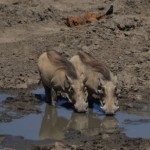
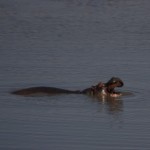

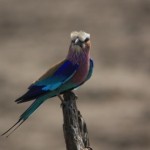 Over the five days in the park we saw plenty of elephant, hippo, lion, giraffe, buffalo, wildebeest, kudu, zebra, impala, waterbuck, sable, warthog, crocodile, baboon, duiker, honey badger, painted dog, rock dassie, ostrich, bush-baby and mongoose. We hope that our Blog readers are suitably impressed…. not so much with the list of animals, but with our new/improved ability to identify what we see! Our knowledge of the various hoofed mammals found in southern Africa was previously so poor that we simply referred to anything in that category (regardless of its size, colour and whether or not it had antlers) as ‘goat’. This gradually progressed to ‘large goat’, ‘small goat’, ‘brown goat’ or ‘grey goat’. The fact that we can now proudly distinguish our springboks from our impalas, and our kudus from our waterbuck, is proof that we have spent some time referring to our book ‘The Guide to African Goats’ 🙂
Over the five days in the park we saw plenty of elephant, hippo, lion, giraffe, buffalo, wildebeest, kudu, zebra, impala, waterbuck, sable, warthog, crocodile, baboon, duiker, honey badger, painted dog, rock dassie, ostrich, bush-baby and mongoose. We hope that our Blog readers are suitably impressed…. not so much with the list of animals, but with our new/improved ability to identify what we see! Our knowledge of the various hoofed mammals found in southern Africa was previously so poor that we simply referred to anything in that category (regardless of its size, colour and whether or not it had antlers) as ‘goat’. This gradually progressed to ‘large goat’, ‘small goat’, ‘brown goat’ or ‘grey goat’. The fact that we can now proudly distinguish our springboks from our impalas, and our kudus from our waterbuck, is proof that we have spent some time referring to our book ‘The Guide to African Goats’ 🙂
We also saw masses of exotic-looking birds. Unfortunately, we have not yet read the informative ‘Guide to African Tweety-pies’ and are therefore not yet sufficiently knowledgeable to identify them other than ‘nice birdies’! This will be Lesson 2 of our ‘Attenborough experience’.
Some of the highlights of our time in Hwange were:
- seeing a lioness and four cubs tucking-in to a buffalo carcass at the side of the track;
- viewing a large herd of buffalo (rather healthier looking than the one featured in the bullet point above) storming into a large waterhole for a mass early-morning slurp, just a few metres from our truck as we sat eating our porridge;
- watching in anticipation as a small herd of twitchy impala drank nervously at a waterhole, being clearly aware of the large crocodile waiting just under the water a few feet in front of them. We waited with the camera ready, hoping to catch the action if the croc snapped. Fortunately (at least for them), the croc decided that today was the impalas’ lucky day and didn’t have them for lunch; and
- holding our breath whilst a tetchy bull-elephant did a ‘mock-charge’ on an open-sided safari vehicle, full of tourists some 50m ahead of us on the road. Rather them than us, we think!
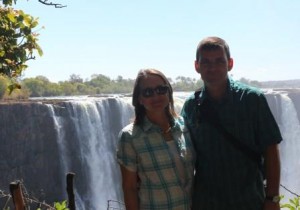 Not far up the road from Hwange is one of the biggest tourist attractions of all. Not merely the biggest in Zimbabwe, or even the biggest in Africa, but one of the biggest tourist hot-spots in the world…… Victoria Falls on the Zambezi River. According to our friend Leon Creese in UK, it is a little known fact that these Falls were named after a well-known English sponge cake (unfortunately Leon, our further research has failed to confirm this alleged fact of historical interest)! 🙂
Not far up the road from Hwange is one of the biggest tourist attractions of all. Not merely the biggest in Zimbabwe, or even the biggest in Africa, but one of the biggest tourist hot-spots in the world…… Victoria Falls on the Zambezi River. According to our friend Leon Creese in UK, it is a little known fact that these Falls were named after a well-known English sponge cake (unfortunately Leon, our further research has failed to confirm this alleged fact of historical interest)! 🙂
Here’s a useless, but more reliable, fact about the Falls: at its peak flow, more water flows over Victoria Falls every minute, than is used in three days by the whole of the City of Johannesburg! We can certainly confirm that the roar of the Falls is so loud, that parking-up for the night over 2 km from the river, we could see the spray-cloud hanging in the air above it and fall asleep to the constant rolling rumble of the cascade in the distance.
We had made arrangements to meet-up in Vic Falls with our German friends Peter and Heike, who are also touring Africa with Cuthbert’s sibling Bocklet truck (better known as the ‘i-Mobil’ to his friends). But before Peter and Heike arrived, we had a few days to explore the area on our own.
No visit to Vic Falls is complete without taking Earl Grey tea on the terrace of The Victoria Falls Hotel. Traditional English high-tea is served overlooking the spectacular gorge, with tiny sandwiches (crusts cut-off, of course!), cream scones and cakes. [Note to Leon Creese: yes, this did include some Victoria sponge cake!]
On a trip into the nearby Zambezi National Park, Cuthbert had his first opportunity to rescue a ‘damsel in distress’. As we rounded a corner we spotted a game-viewing vehicle stopped in the bushes at the side of the road. It turned out that, no…. it was not stopped to watch some interesting animal activity…. the lady was returning to the park after dropping some tourists in Vic Falls town and in her haste, had skidded off the road. No harm done, but she was going nowhere fast, with her wheels well and truly dug-in to the deep, soft sand up to the axles. Nothing that a Cuthbert winch couldn’t handle! In a few minutes, she was back on the road.
We had a lovely couple of days with Peter and Heike. First, returning to that colonial terrace of The Victoria Falls Hotel (this time for very civilised sun-downer cocktails), then visiting the Falls and camping out of town by the river. We very much enjoyed catching up with them and hearing news of their travels. They were also able to pass on ‘second hand’ some good advice that they had learned from a Swiss couple that they had met on their travels. Peter and Susannah, we heard, were long-standing world-wide over-landers, currently travelling around Africa in a Bremach truck that they had, rather impressively, built into a camper-van themselves. Our friends Peter and Heike had particularly liked this truck and told us much about ‘The Swiss Couple’ and their travels (bear with me on this story …. the relevance of this will become apparent as you read on below …..).
After saying farewell to Peter and Heike, we set off east-wards from Vic Falls heading around the south side of Lake Kariba, towards the famous Kariba Dam at the other end.
Yes… we had read the guide books that this is a long, rough route, with long very bad tracks. It is remote, with long distances with no shops or fuel stations along the way and, and, and, and… did we mention it’s a long way….? Well we wanted to do it anyway. We’re in no hurry. If it takes us a few days to do the 400+km, then so be it. And it looked an interesting route.
The alternative would be to take a car-ferry from Mlibizi directly across the lake to Kariba town, taking 24 hrs. Our guide book notes that it sails very infrequently, so we had decided against investigating the boat option any further. However we had received a recommendation to camp by the lake at the site immediately adjacent to the ferry departure ramp. As we checked-in at the camp-site, we were surprised when the lady assumed that we were there to catch the ferry…… the next morning. Actually no, we planned to drive south around the Lake. Hmmmm. The other campers in the site were gathering there to board the boat in the morning and expressed politely their surprise at our plan to do the road-trip…… did we know how long this route was? How rough it was?
In the morning we watched the other campers at the ferry ramp (it would be a misleading exaggeration to use the term ‘port’ here) boarding the small vessel for the voyage. There was some delay to boarding as a roof tent had to be removed to get one of the vehicles on the ferry. Then we set off on our drive, hoping that we wouldn’t regret the decision to: (a) enjoy a remote and scenic part of Zimbabwe; and (b) save the US$500 fare.
Some time later as we drove through the village of Binga, we saw a Bremach camper-van coming towards us with a red/white-cross flag on the bonnet. The patient amongst you will now be rewarded for your attention earlier…… it was ‘The Swiss Couple’! Peter and Heike had not only given us a good account of them, but had also given The Swiss Couple a comprehensive account of us! We instantly recognised each other and stopped for greetings at the side of the road like old friends! Slightly bizarre to meet someone and know so much about them before even meeting them.
“A stunningly beautiful but rarely visited National Park…. but…” our guide book continued “…you may wish to consider the reasons why.” Apparently it is little visited because: 1. very limited accommodation options; 2. not just ‘bad’, but ‘terrible’ rough roads; and 3. due to high levels of game poaching, there is little wildlife and for the same reason, the few remaining elephants can be aggressive. Hmmm. Not exactly the tourist-friendly features!
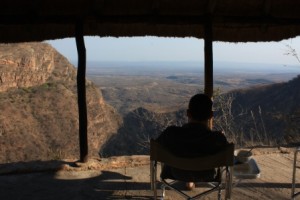
Camp-site with a view… the safety railings across the sheer drop into the gorge, appear to be missing!
The prospect of limited accommodation and poor roads doesn’t really bother us in Cuthbert: we don’t need any facilities and Cuthbert can cope with pretty much any kind of rough track (provided there aren’t too many low tree branches, which unfortunately the guide-books never seem to mention!). Not so keen on bumping into the poachers or the aggressive ellies, though!
We decided to go into the Park, but only to the first camp-site, just a few miles inside the gate, which in any case is said to be the most beautiful site perched on the side of an escarpment. It was a steep and rough track up to the top of the escarpment, but it turned out to be a good decision: it was a truly amazing camp-spot with spectacular views. Immediately in front of the campsite there is a sheer drop of several hundred feet into the gorge below. Of course Zimbabwean health and safety standards provided carefully placed railings and barriers…. NOT! Sleep-walkers should probably stay away from this one….. it is a single site, so you are really out on your own up there, truly ‘on the edge’! Unfortunately the photos don’t quite do it justice, but you can get the idea… maybe go and see it for yourself sometime??J
After Chizarira we continued the (long) road east and then north around Lake Kariba up to the Kariba Dam. En-route, we encountered a mini-bus stuck on a steep, sandy section of the track. As the driver flagged us down and pleaded for a tow by Cuthbert, a stream of people slowly emerged from the side-door onto the verge. It was like watching a magician pulling rabbits out of a hat! At least 20 people and several goats emerged from the 10-seater mini-bus, and the people were not all, shall we say… ‘petite’. With this weight, it does not require the brain of Einstein to work out why the wheels got stuck in the sand, particularly with the additional stack of luggage on the roof. Cuthbert came to the rescue – it only took a few minutes to put them out of the soft sand. The grateful passengers cheered and clapped as we drove onwards!
It is probably possible to do the route from Chizarira to Kariba in a day, but it would be an (even more) arduous slog. We took our time, enjoyed the very scenic countryside and made a wild-camp overnight stop along the way.
On the route nearing Kariba, there is an annotation on the T4A Map: “River crossing 4 wheel drive only”….. here’s the short video of Cuthbert to show why:
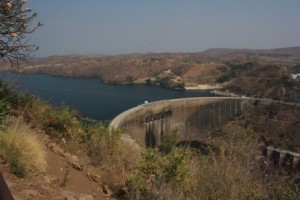 As we had been promised by the travellers boarding the ferry back in Mlibizi, the route to Kariba was indeed very long. And rough. Particularly on the track cutting northwards over the ridges around the western boundary of Matusadona National Park, then dropping down the escarpment into the Kariba Lake valley. But wow! What an end to our journey through Zimbabwe! This little-driven route is rough and challenging in places, but truly beautiful and certainly well worth the effort!
As we had been promised by the travellers boarding the ferry back in Mlibizi, the route to Kariba was indeed very long. And rough. Particularly on the track cutting northwards over the ridges around the western boundary of Matusadona National Park, then dropping down the escarpment into the Kariba Lake valley. But wow! What an end to our journey through Zimbabwe! This little-driven route is rough and challenging in places, but truly beautiful and certainly well worth the effort!
We are spending our final few days in Zim on the shore of Lake Kariba near the famous, impressive Dam. The wild-life roams freely around Kariba town; as I type this blog sat in the back of Cuthbert, an elephant has just walked past the window five or six feet away, munching on the trees in the camp-site!
As we noted in the introduction above, we are posting this whole Zim-Blog as we leave the country. The prevailing advice to travel-bloggers of not leaving themselves open to allegations of ‘unauthorised journalism’, is an indication of Zimbabwe’s difficult reputation on the international scene.
It would be naïve to underestimate the country’s problems; but for tourism at least, Zimbabwe is definitely ‘on the up’. The once modern infrastructure in the National Parks clearly lacks investment in maintenance, which is a great shame. But near many of the main tourist attractions there are plenty of good quality, privately run lodges and campsites, which are as good as anywhere else in Africa. The main roads are well surfaced, the supermarkets are well stocked and fuel is widely available at a reasonable price.
Perhaps most importantly, we can say with no hesitation (but with apologies to the South African, Namibian and Botswanan people!) that Zimbabweans are the most friendly, helpful and welcoming people that we have met in Africa so far, and probably in the rest of the world! We have been ‘blown away’ by the warmth of the reception here. This warmth seems more than mere gratitude that visitors are now returning to Zimbabwe; there is a genuine friendliness here and an absence of that feeling of opportunistic commercial exploitation, which prevails in many popular tourist locations around the world. This is probably one of the most compelling reasons to include Zimbabwe on any travel itinerary in southern Africa.
Here is a quick overview map of our route in Zim so far, but we will be back to see the eastern side of the country when we do our route back to South Africa next year.
Now move swiftly on to the Zambia page for the continuing tales….
And later… in Feb 2015 we returned to Zimbabwe to tour the eastern side. See the full story at Return to Zimbabwe.
Note: This Zimbabwe Blog was written contemporaneously (wow, that’s a big word!) as we travelled over the last 4 weeks, but due to restrictions on ‘publishing and journalism’ in Zimbabwe, we did not posted it until we had left Zimbabwe for Zambia in September 2014.


